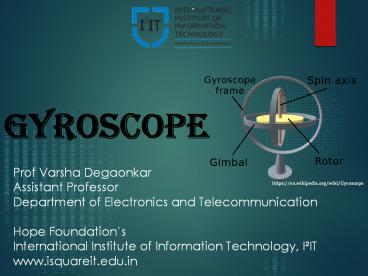Gyroscope - Department of Electronics & Telecommunication Engineering - PowerPoint PPT Presentation
Title:
Gyroscope - Department of Electronics & Telecommunication Engineering
Description:
A presentation on Gyroscope, and is presented by Prof. Varsha Degaonkar, from the department of Electronics & Telecommunication Engineering at International Institute of Information Technology, I²IT. Topics covered under this presentation are Principle of Operation, Rotary (classical) Gyroscopes, Vibrating Structure Gyroscopes, Specifications and Selection Criteria. – PowerPoint PPT presentation
Number of Views:168
Learn more at:
http://www.isquareit.edu.in/
Title: Gyroscope - Department of Electronics & Telecommunication Engineering
1
gyroscope
Prof Varsha Degaonkar Assistant
Professor Department of Electronics and
Telecommunication Hope Foundations
International Institute of Information
Technology, I²IT www.isquareit.edu.in
https//en.wikipedia.org/wiki/Gyroscope
2
Introduction
- Gyroscope
- Used for navigation
- Used for measuring angular velocity.
- rotational velocity can be measured in 1, 2, or 3
directions. - 3 axis gyroscopes can provide a full 6
degree-of-freedom in motion tracking system with
a 3-axis accelerometer
https//en.wikipedia.org/wiki/Gyroscope
International Institute of Information
Technology, I²IT, P-14 Rajiv Gandhi Infotech
Park, Hinjawadi, Pune - 411 057 Tel - 91 20
22933441 / 2 / 3 Website - www.isquareit.edu.i
n Email - info_at_isquareit.edu.in
3
Principle of Operation
- Orientation is determined with use of Earths
gravity - Evolved from mechanical-inertial spinning devices
which consists of rotors, axles, and gimbals - Types of gyroscopes
- Rotary (classical) gyroscope
- Vibrating Structure Gyroscope
- Optical Gyroscope
https//en.wikipedia.org/wiki/Gyroscope
4
Rotary (classical) Gyroscopes
- The law of conservation of angular momentum is
used in the Rotary (classical) gyroscope. Which
says that system will get constant angular
momentum in direction and magnitude if the
system has zero the resultant external torque . - It consists of spinning disk or mass on axle, a
series of gimbals - Additional degree of rotational freedom is given
by gimbals. - Fig. 1 Rotary Gyroscope
- https//en.wikipedia.org/wiki/Gyroscope
5
Vibrating Structure Gyroscopes
- Vibrating structure gyroscopes are MEMS
(Micro-machined Electro-Mechanical Systems)
devices - The operation uses principle of Coriolis force.
- The Coriolis force is proportional to both the
angular velocity of the rotating object and the
velocity of the object moving towards or away
from the axis of rotation.
https//en.wikipedia.org/wiki/Gyroscope
6
Specifications
- Measurement range
- Number of sensing axes
- Nonlinearity
- Working temperature range
- Shock Survivability
- Bias Instability
- Angular Random Walk (ARW
- Bias
- Bias Drift
- Bandwidth
7
Selection Criteria
- Nonlinearity
- Noise density
- Bias repeatability
- Acceleration sensitivity
- Sensitivity to vibration
- Sensitivity to linear accelerationor g
sensitivity - Environmental Factors- Temperature
- Availability
- Cost
8
(No Transcript)































